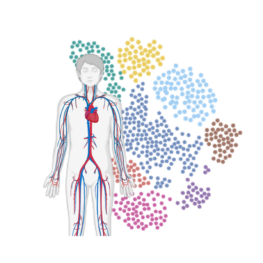“My SPARK award has propelled my career forward. It has not only provided funds for me to pursue an important, clinically relevant question, but it has also given me the confidence to continue on my career path in pursuit of an independent academic position.”
What if we could target pro-tumoral immune cells while leaving infectious-disease fighting immune cells unharmed?
Funded: January 2022
Funded By: The generosity of LJI Board Director Tom Tullie and the Tullie Family
What was the goal of your SPARK project?
My SPARK award supported work to understand how the immune cells that prevent infection differ from immune cells that support tumor progression in melanoma patients. To do this, I utilized a new technology, called CITE-seq, to understand the markers present on the outside of cells and associate them with an anti-bacterial or pro-tumoral phenotype.
I worked with a larger group of colleagues to design a custom reagent necessary for the proposed experiments. After a long delay, the custom reagent finally arrived and we performed the large-scale proposed experiment. The downstream analysis is now underway. We are working through the pipeline, striving to optimize the analysis for neutrophil detection. Once we clean up the data, we will look for the pro-tumoral and antibacterial neutrophils and interrogate how they change from healthy individuals to cancer patients.
Did you face any challenges?
I experienced delays in the development of a custom reagent that was imperative to the experiments in my project. To adjust, I simply delayed the experiment until the arrival of the custom reagent. This means I am not as far along in the analysis as I had hoped I would be at this point. Because the custom reagent was critical to the novelty of the study, it was reasonable to delay results rather than pivoting to something more widely available.
SPARK project results:
I used the new technology, CITE-seq, to profile immune cells, including neutrophils, in the blood of healthy human donors and melanoma patients. Samples from two healthy donors and three melanoma patients were collected as part of this project. From each donor, I collected 20,000 cells (40,000 from one melanoma patient), double what was previously possible with an older model of the cell separator. I then measured 201 molecular targets on the outside of the cells, a major advance compared to previous technology, which allowed us to detect 40-50 targets on the outside of the cell. Detection of the molecular signature on the outside of the cell is what makes CITE-seq unique and particularly poised to better detect neutrophils. I went on to perform a deeper-than-usual analysis on the molecular signature on the inside of the cell. Last, I combined the SPARKfunded samples with a similar analysis on human bone marrow. Because these data were collected and analyzed together, I can look across these samples to have a more integrated understanding of what is going on in the immune system during healthy periods and in cancer development. In short, I collected a large dataset. I have a plan to tackle the data and come up with answers as well as more hypotheses and questions. I expect to find subsets of neutrophils that are new and identifiable as pro-tumoral or anti-bacterial. We will then identify unique molecular signatures on the surface of these subsets. The cell surface location of the molecular signatures makes them prime drug targets. In the end, I will devise strategies to target bad pro-tumoral neutrophils while leaving good antibacterial neutrophils intact.
What’s next for this project?
The final analysis for my SPARK project will provide new drug targets that I can work to move towards the clinic. I will take the identified targets on pro-tumoral neutrophils and develop drugs that will work to deplete these harmful cells in cancer patients. If I find a marker that is specific to the anti-bacterial neutrophils, I will look for ways to engage that molecule to promote infection fighting functions of neutrophils. I can then study mouse models to determine if this strategy might work to tackle cancers. I will test
the effects of these drugs on tumor growth as well as whether the drugs leave an individual susceptible to infection. This preclinical work in a mouse model will pave the way to clinical application.
I will prepare a publication during the next year. The target journal and story will depend on the results found, but this research would likely serve as a resource paper in a journal such as Immunity or Nature Immunology.
What’s next for Melissa?
I plan to launch my independent research career using the hypotheses I generate from this dataset. So, I plan to apply for early stage investigator grants and R01 or R21 using the data generate from this project. Those grant applications will begin later this year.
I hope to finish up my postdoctoral fellowship in the next year. This fall, I will go on the academic job market with hopes of landing an assistant professor position in the midwest studying aspects of targetable myeloid biology in disease.
